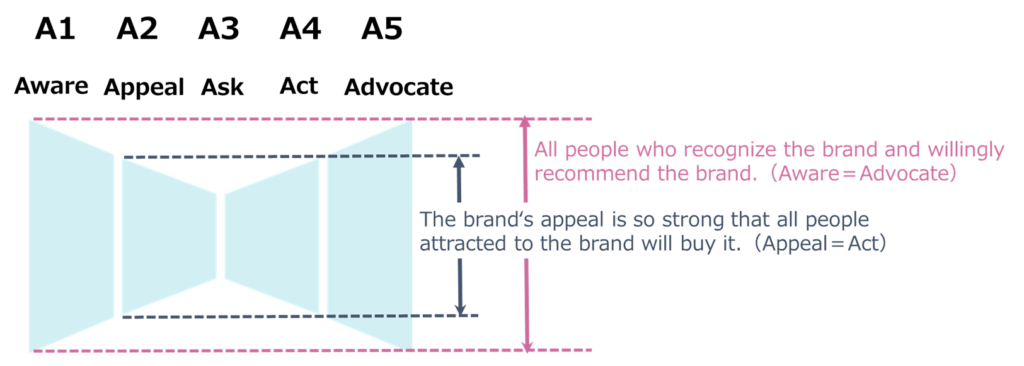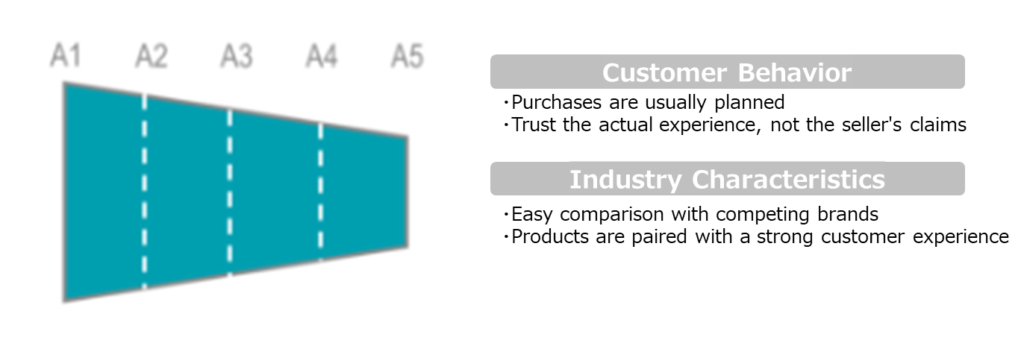The customer journey is how a customer progresses along the path from brand unawareness to awareness, to interest, to purchase, and then to recommendation. The customer journey can be complex and varied, influenced by a variety of things such as the geography surrounding the brand, market characteristics, price point, and frequency of purchase, and can vary from company to company and service to service.
Contents
Customer journey typology defined the ideal bow-tie 5A model

Marketing 4.0 simplified the customer journey and summarized it into a general 5A (A1 = Awareness, A2 = Appeal, A3 = Ask, A4 = Act, A5 = Advocate) framework, classifying various industries into four patterns: ①doorknob type, ②goldfish type, ③trumpet type and ④funnel type.

From there, the ideal form of the 5A model, which incorporated the advantages of various industries, became the bow-tie shape.
Understanding the differences between the bow tie pattern and the pattern to which your company belongs will help you understand how to address challenges, what success factors are present, and identify opportunities for improvement.
What are the bow-tie-shaped features that showcase the brand’s perfect appearance?
What is the ideal bow-tie-shaped 5A model in a state of realization?

- All people who are aware of the brand will voluntarily advocate the brand (Aware = Advocate)
- Brand appeal is so strong that everyone attracted to the brand will buy it (Appeal = Act)
- Customers do not feel the need to research the brand on their own, and the volume of Ask is at its lowest
Customers do not feel the need to research the brand on their own, and the volume of Ask is at its lowest
Thus, the bow-tie 5A model is established.
Customer Journey Archetypes: Four Customer Journeys
①Doorknob-type customer journey

The most common of the four patterns, and the most representative, is the consumer packaged goods industry.
Due to the low price of the product and the high frequency of purchase, customers do not feel the need to learn more about the brand. Therefore, without much research, they make instant and impulsive purchases, influenced by easy availability, relatively low prices, and attractive promotions. Because of these characteristics, customers are less likely to feel attached to a brand and are less likely to recommend it.
Brand switching is frequent due to the frequency of appealing marketing communications and other factors. Brands need to strengthen their engagement programs to increase customer loyalty and level of affinity.
②Goldfish-type customer journey

This pattern is mainly seen in business-to-business (B2B) transactions.
Often, the client is not an individual, but a team in which a wealth of expertise and interests exist. Their research and evaluation process is thorough, and appeals have little or no effect. Because there are several similar competitors, evaluation results across brands tend to be similar, and familiarity with the brand is often the determining factor.
The level of commitment and familiarity, and even curiosity, should be optimized by differentiating it from its competitors and improving its communication, but it will face the toughest challenges because it is generally dealing with a hundred customers.
③Trumpet-type customer journey

This pattern is mainly seen in lifestyle categories such as luxury cars and luxury watches.
Having already built a strong and unique credibility in terms of quality, the customer evaluation process is an easy one, despite the high price. The rarity of the product attracts and holds many fans, including those who cannot financially afford to buy it. The most important feature is the volume of recommendations rather than actions, as customers tend to actively recommend a brand even if they have not purchased or used it themselves. Since scarcity is appealing to potential buyers, it is best to increase the level of commitment by improving accessibility, while being careful not to weaken it.
④Funnel-type customer journey

This is a pattern seen primarily in the durable goods and service industries, where designing a holistic customer experience is important because customers go through all stages of the customer journey.
Purchases are planned, and customers value experience over brand claims. They will not make a recommendation if they don’t like it, so brand positioning must be deeply rooted in the experience, not superficial. Although brand switches are infrequent, customers expect a better customer experience, so disruptive innovation is most likely to occur in this category, and novel improvements and customer experience innovation are key challenges for brands. It is best to strike a balance between sales and after-sales service to increase the level of familiarity and commitment.
Each service and each company will be required to plan and execute measures to realize a bow-tie-type customer journey to realize a better customer relationship according to each situation.

